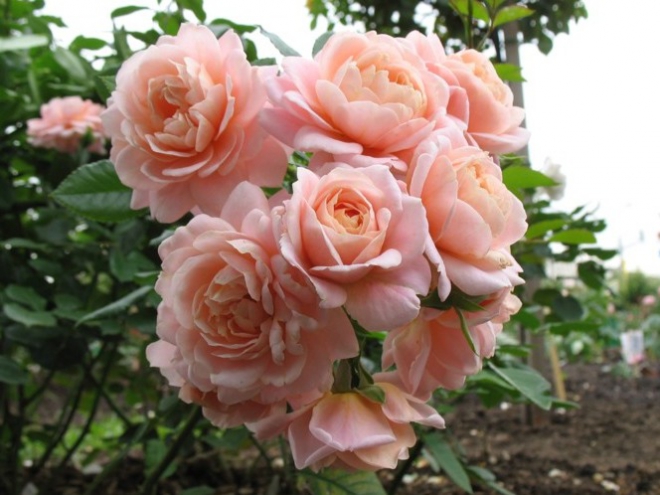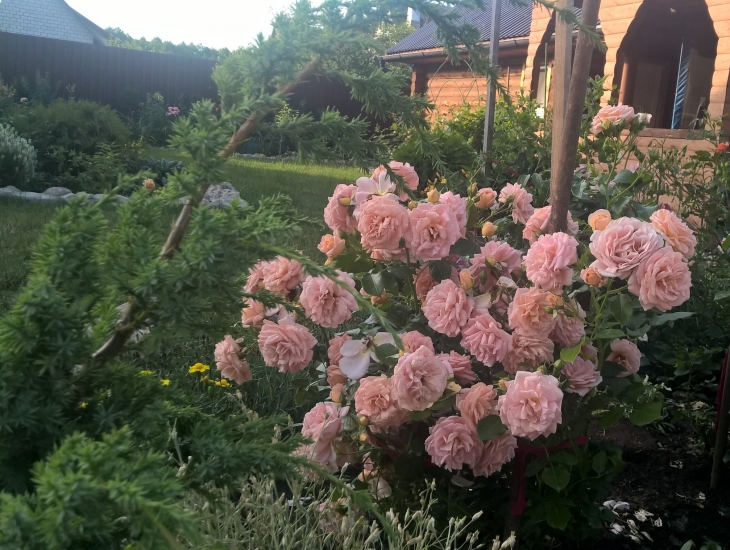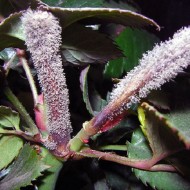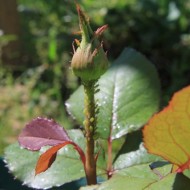What is the uniqueness of the Geisha rose: description and features of cultivation
Content
Breeding history of the variety
A hybrid tea variety was bred in 2007 by German breeders from the Tantau company. The flower, obtained by a team of scientists led by Hans Jürgen Ewers, was registered under the name Geisha and given the market name TANshei. Very quickly, not only Germany, but also other European countries learned about the variety. The rose soon became known outside the continent.

Description and characteristics of the Geisha rose
The hybrid tea cultivar is a compact dense bush with a height of 0.9-1.2 m and a diameter of 0.5-0.6 m. The stems are straight, strong, covered with small thorny thorns. The leaf plates are medium in size, glossy, emerald green. On each peduncle, 4-5 densely double buds 60-70 mm in size are formed. They consist of large, slightly curved backward marginal petals, which become smaller closer to the center. The color is creamy pink with a peach tint. Dissolving, the inflorescences do not fully open, leaving the yellow-orange core closed.
The Geisha rose blooms profusely and continuously from early summer to mid-autumn. Three such waves of flowering can be observed during the whole season. All this time, decorative bushes emit a delicate, subtle floral aroma.

Advantages and disadvantages of the variety
A hybrid floribunda has many advantages and is practically devoid of disadvantages.
- high decorative qualities;
- continuous triple flowering;
- frost resistance (up to -23 ° С);
- drought resistance;
- high immunity to diseases and pests;
- the ability to stand in the cut for up to 1.5 weeks.
- with excessive moisture, the risk of fungal infections increases;
- from a lack of sunny color, the plant loses its decorative effect;
- poor aroma.
Video "Geisha Rose in the Garden"
This video covers the main characteristics of the variety.
Agrotechnics of garden rose Geisha
Like all hybrids, this variety is undemanding to care and fairly easy to cultivate. In order for the flower to take root well, and later please you with abundant flowering, you should adhere to the basic agrotechnical rules.
Landing rules
Young bushes are planted twice a season:
- from the second half of April to the third decade of May;
- from the end of September to the first night cold snaps.
The soil temperature for planting should not be lower than +10 ° С.
The site is chosen well-lit, with the occurrence of groundwater no higher than 1 m.In shade or near fences, floribunda cannot be planted, otherwise a lack of light will lead to a decrease in the number of buds and their discoloration. The soil should be nutritious, with good permeability. For a rose, loamy or black earth soils are suitable, in which the pH level is 6.0-6.5.
The landing site is prepared in advance.For 14 days, planting holes are dug 40x40 cm in size with an interval of 0.4-0.6 m from each other. A drainage layer is laid out at the bottom and a little earth is poured. The seedling is placed in the hole, gently straightening the rhizome. Top up with the rest of the soil, and then lay out a layer of mulch.

Watering, weeding and loosening
The soil under the roses must be constantly loosened. This will ensure normal access of oxygen and nutrients to the plant's root system, preventing it from rotting. It is also necessary to regularly remove weeds by weeding the area around the bush.
Since the hybrid tea floribunda does not like waterlogging, it is watered only after the soil has completely dried out. One flower requires about 10 liters of lukewarm water. Watering is carried out only at the root, without affecting the green aboveground part.
Pinching and pruning shoots
In the first year after planting, the rose is not allowed to bloom, removing all set inflorescences. Then they begin to form a crown, pinching the shoots to the fourth leaf. In the second and subsequent years, pruning is carried out every spring, cutting off 2/3 of the length of the branches, leaving no more than five buds. Those stems on which eyes have not formed are removed at the root.
Wintering plants
They begin to prepare the plant for wintering when the temperature drops below -7 ° C. The soil around the flowers is dug up together with peat, sawdust or sand. Further, the bushes are covered with coniferous spruce branches. At a height of no more than 0.2 m above the rose garden, a frame is installed, which is covered with spunbond from above. Covering the top with polyethylene, they make a kind of greenhouse, leaving small holes on the sides.
Diseases and pests
Since the hybrid floribunda is highly immune, problems can only arise with improper care. So, from excessive watering or poor soil permeability, root rot begins to form. When weeds grow around the bush, the green part of the plant can be affected by mold.
Sometimes the flower can be attacked by pests. Most often, aphids or spider mites settle on it. If you do not take action in time, you can lose the entire bush entirely. In the fight against parasites, spraying with insecticides, for example, Aktellikom, will help.
- Signs of rot on roses
- Spider mite
- Rose aphid
Application of the Geisha rose in garden decor
German floribunda looks great in a mono flower or group planting. She can decorate curbs, paths, open gazebos, combine with other garden plants.
The tea hybrid is combined with almost all ornamental crops. It harmoniously coexists next to conifers (juniper, thuja, cypress, spruce). Looks good near large shrubs (sea buckthorn, yellow acacia, lilac, cotoneaster, pyracantha, tamarix, scumpia). An excellent option can be a snowberry, privet or mock orange.

Gardeners reviews
“I have been raising Geisha for a long time. For a couple of decades, a whole rose garden has been formed at the dacha. Incredibly beautiful flowers! They bloom continuously all summer and even in autumn, and require minimal care. No wonder the reviews about these roses are only positive. "
“I started doing Floribundas quite recently. For a long time I selected suitable varieties that would tolerate the heat well. I reread many descriptions and settled on TANshei. Indeed, the flower feels great in dry weather, which does not in any way affect the quality of flowering. "
“Knowing how much I love roses, the Geisha was given to me as a birthday present the year before last.I was very worried about how this unusual variety would be accepted, but the bush quickly adapted and the next year threw out a lot of buds. "
The romantic tea floribunda is a truly unique flower that has no equal among other hybrids. Having existed on the market for a little more than ten years, the variety has already managed to fall in love with many flower growers and receive prestigious awards at international competitions.



